Special senses III Hearing
1/72
There's no tags or description
Looks like no tags are added yet.
Name | Mastery | Learn | Test | Matching | Spaced |
|---|
No study sessions yet.
73 Terms
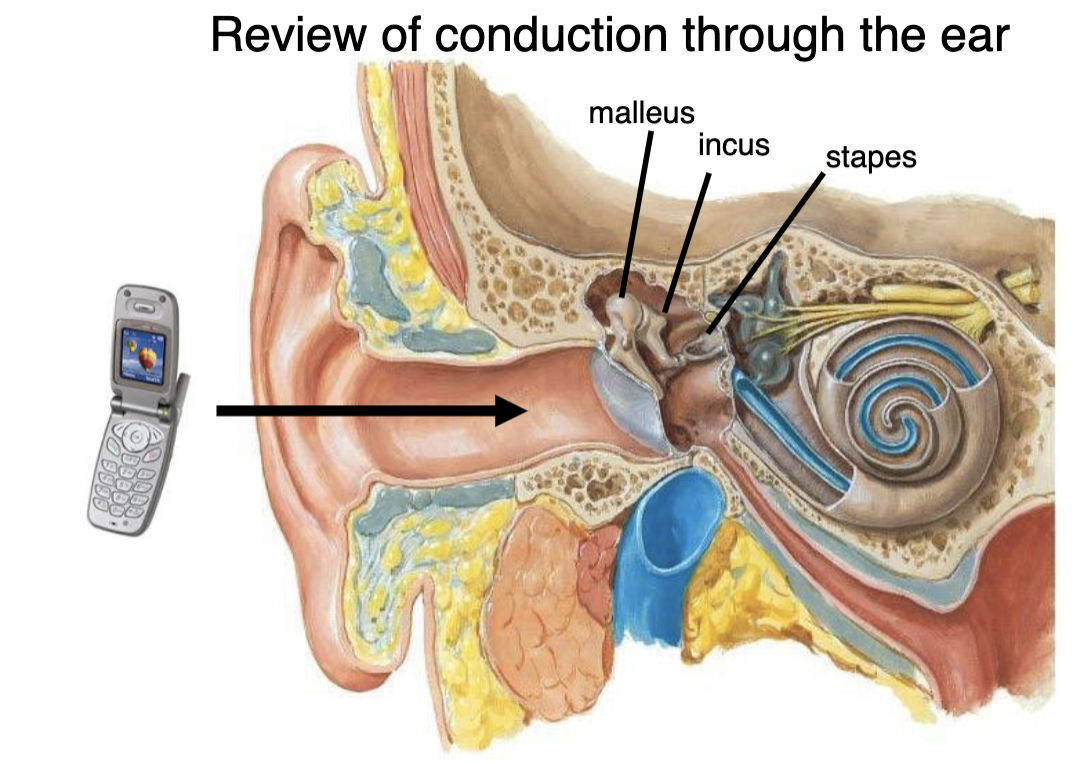
how does conduction occur through the ear?
sound waves funneled down external acoustic meatus to the tympanic membrane
ossicles in middle ear transfer energy to oval window
mechanical energy generated by ossicles transferred to fluid of inner ear (perilymph and endolymph) through the oval window
fluid waves travel through the cochlea
what are the types of acoustic stimuli?
intensity
tone
position
what is intensity?
loudness, encoded by the number of neurons and rate of action potential firing
what is tone?
pitch, which part of the Organ of Corti is most active
what is position?
location, CNS compares the difference in sound between the 2 ears
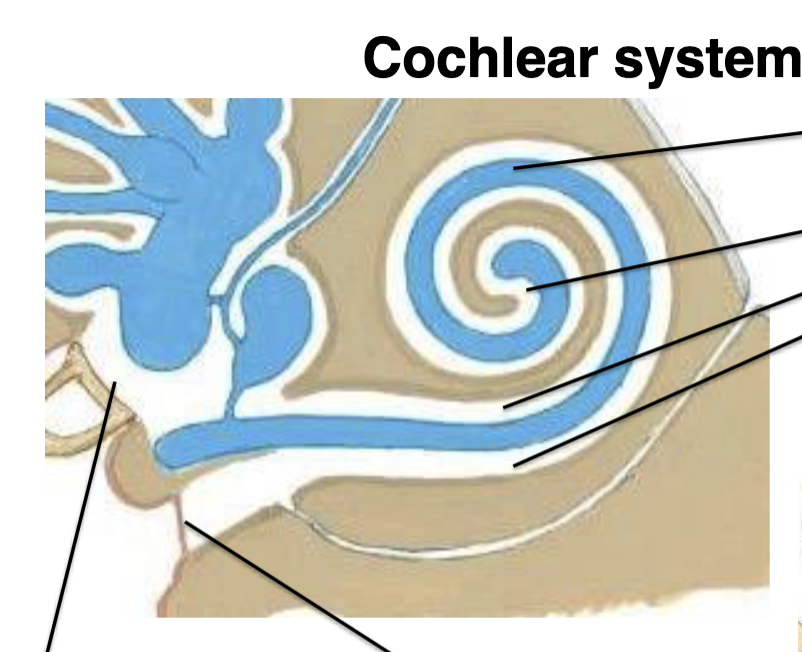
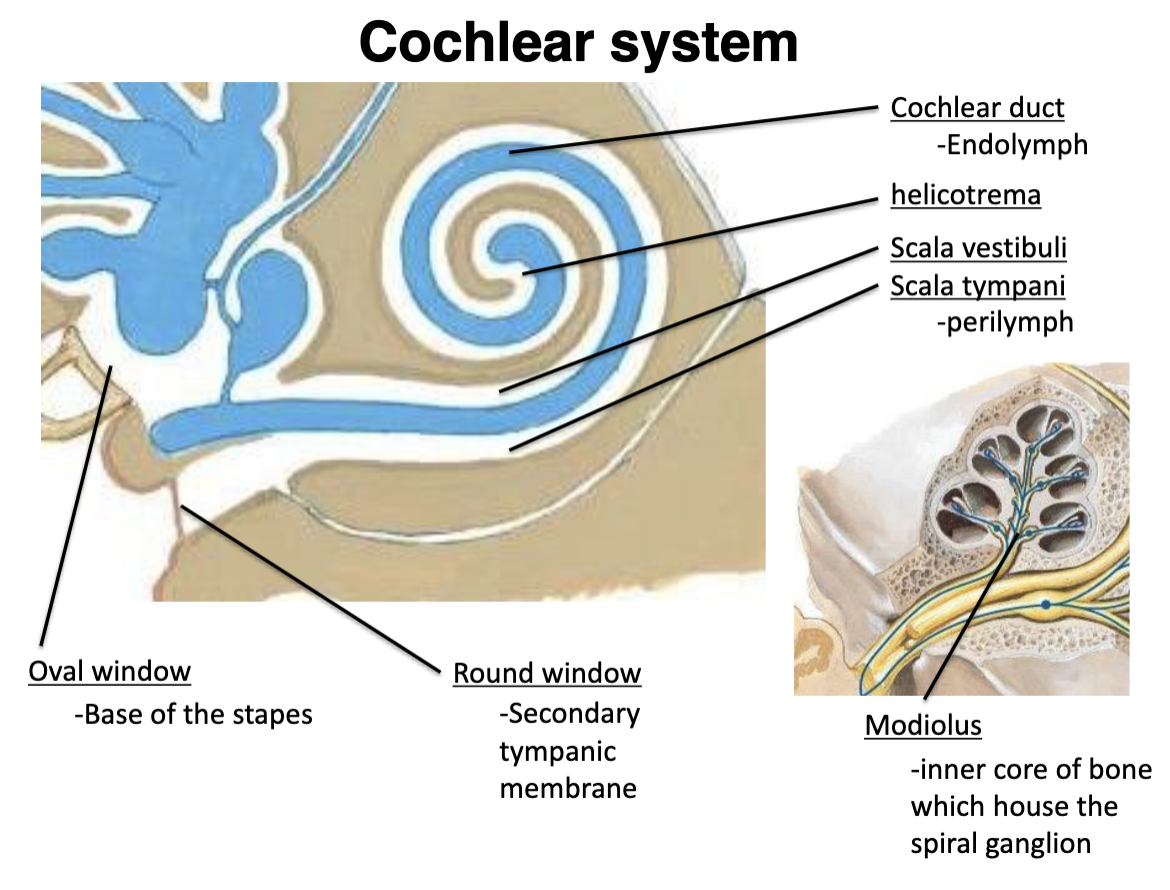
what is the inner core of bone that houses the spiral ganglion?
modiolus
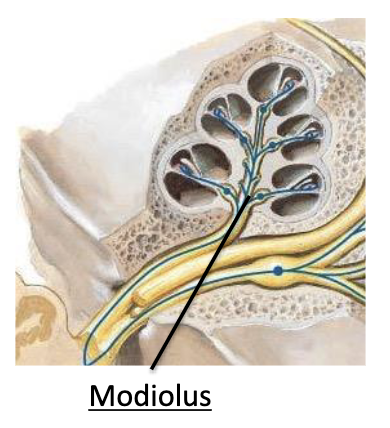
which part of the cochlear system is filled with endolymph? perilymph?
cochlear duct → endolymph
scala tympani → perilymph
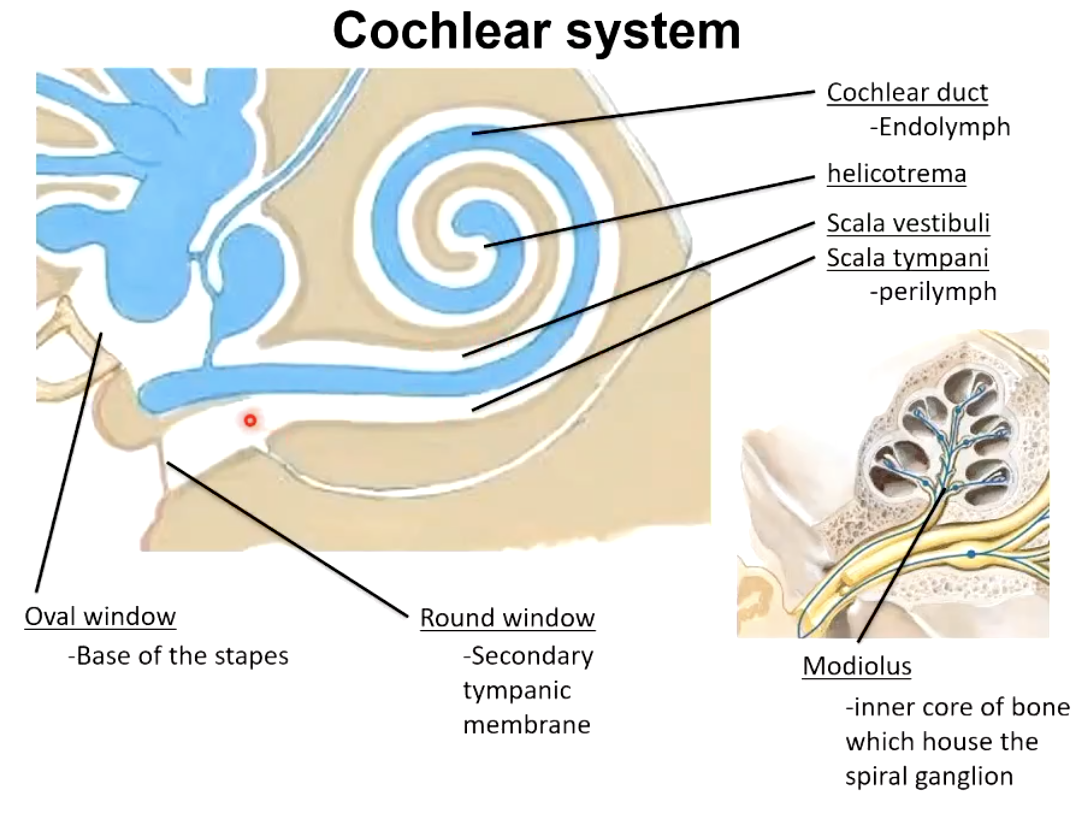
what is the base of the stapes called?
oval window
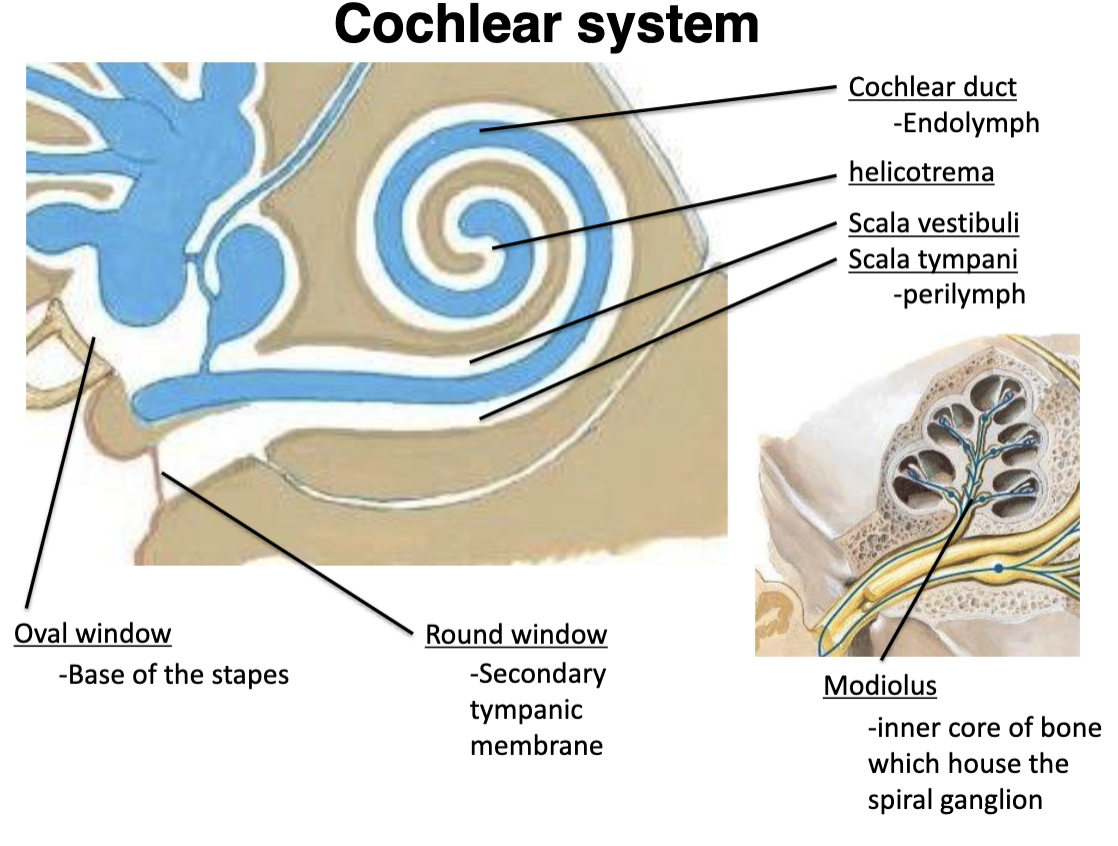
what is the secondary tympanic membrane called?
round window
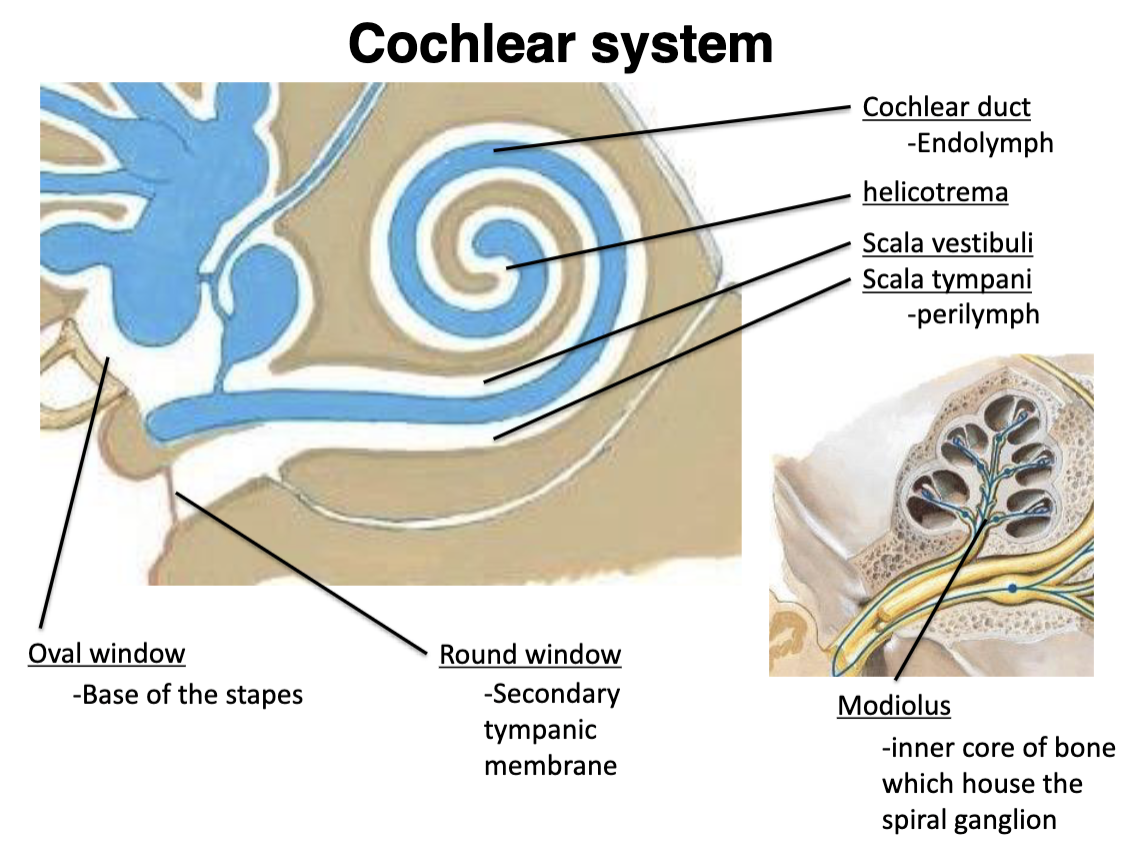

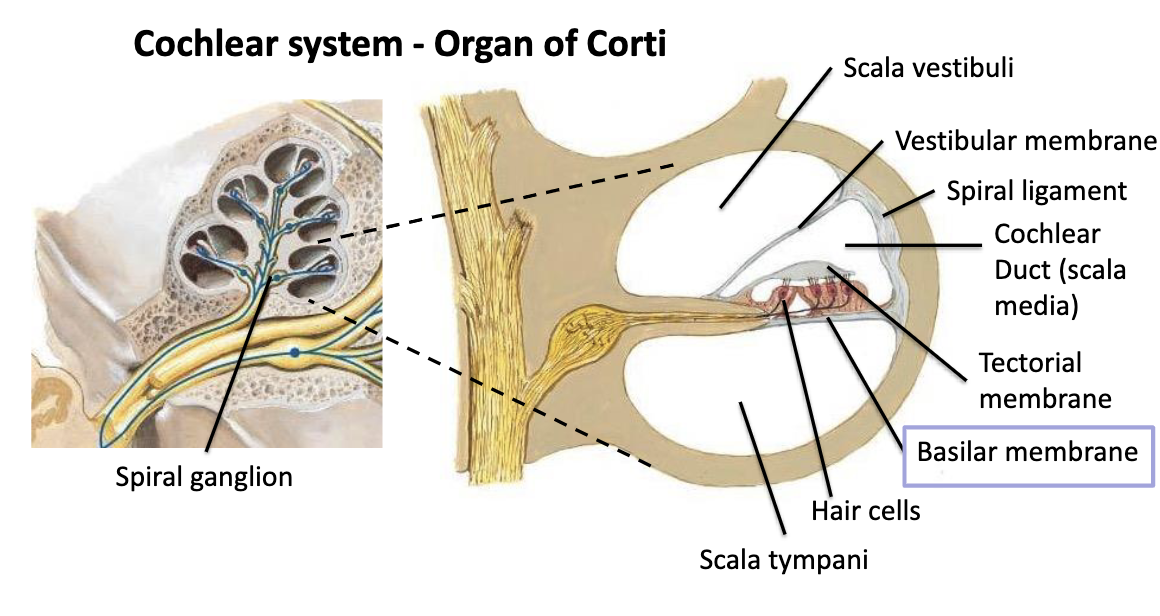
Certain regions of the basilar membrane vibrate in response to specific frequencies, this causes…?
the hair cells in that region to move more than in other regions
which end of the basilar membrane is narrow, stiff and conducts really high pitched sounds?
basal end

which end of the basilar membrane is wide, floppy and conducts really low pitched sounds?
apical end

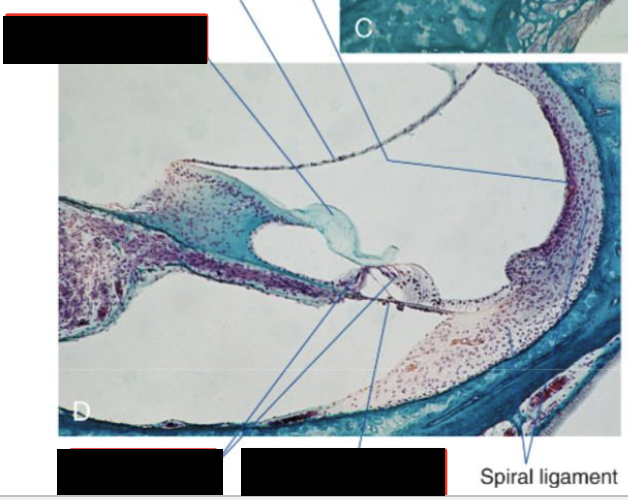
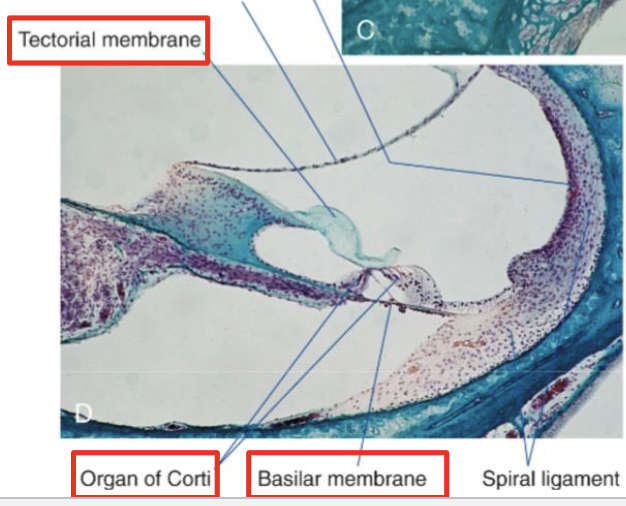
inner and outer hair cells are both innervated by…?
CN VIII
what do hair cells in the organ of corti do?
transduce movement within organ of corti into signals that will be sent to CNS
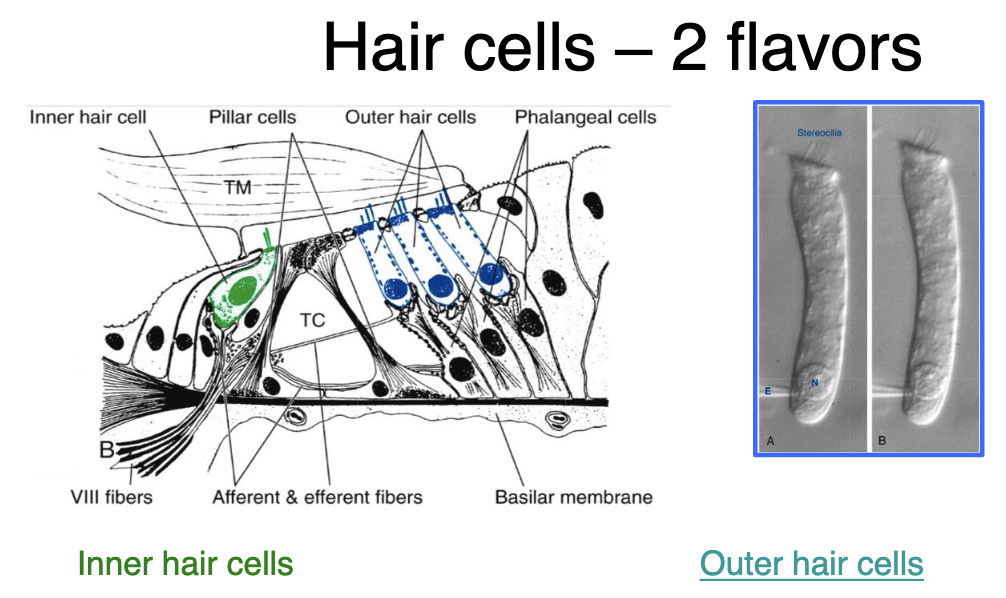
characteristics of outer hair cells?
stereocilia embedded in tectorial membrane
located toward middle of basilar membrane
afferrent AND efferent innervation
change shape
amplify soft sounds

characteristics of inner hair cells?
stereocilia in endolymph
located toward inner edge of basilar membrnae
afferent nerve endings
main component for hearing
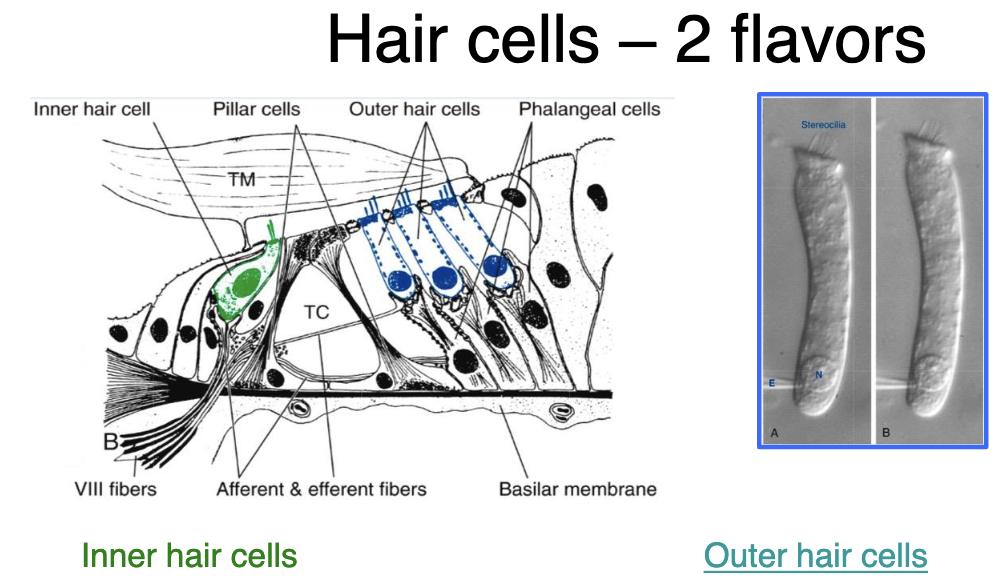
what are basal inner hair cells most easily damaged by?
long-term exposure to high pitched sounds
inner vs outer hair cells: # at birth
inner → 3,500 (only 1 row)
outer → 12,000 (3 rows)
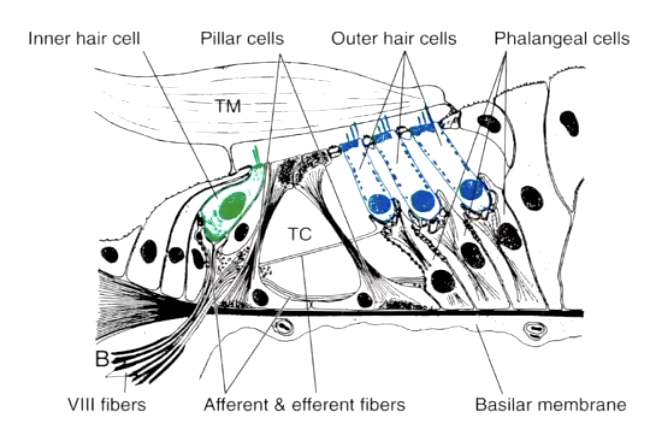
inner vs outer hair cells: location
inner → located toward inner edge of basilar membrane
outer → located toward middle of basilar membrane

inner vs outer hair cells: what is it embedded in?
inner → stereocilia in endolymph
outer → stereocilia embedded in tectorial membrane
inner vs outer hair cells: afferent vs efferent
inner → base has numerous afferent nerve ending
outer → both afferent and efferent innervation
inner vs outer hair cells: function
inner → main component for hearing
outer → change shape to amplify soft sounds
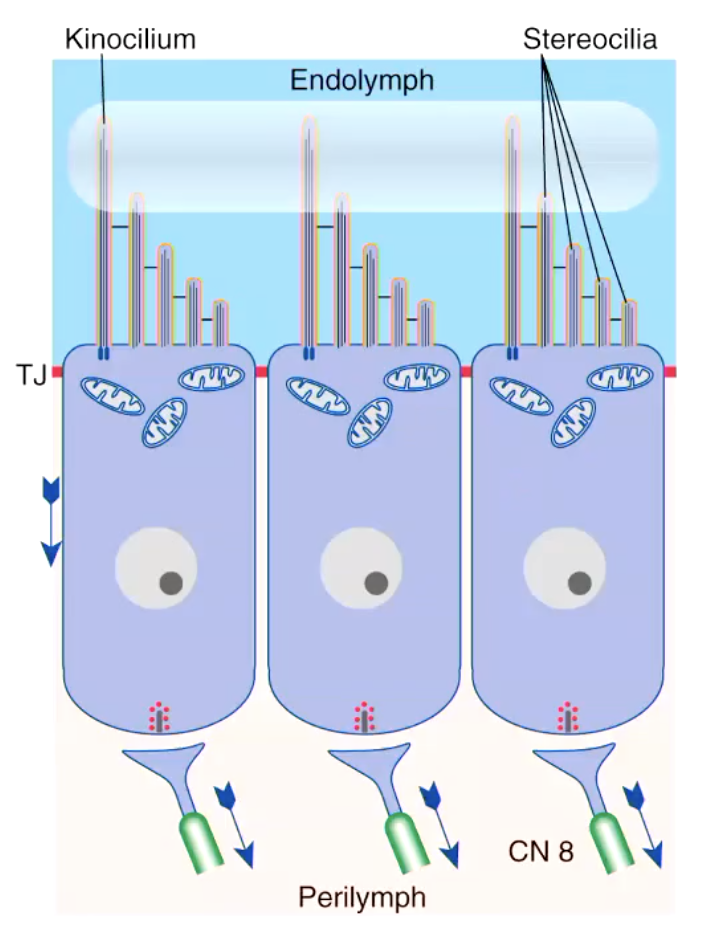
how do hair cells convert mechanical energy to an electrochemical signal?
stereocilia at apical endolymph side of cell are attached to longer kinocilium
when they move, mechanically-gated ion channels at base of kinocilium open
allows K+ enters cell from endolymph
resulting depolarization of cell opens voltage-gated Ca2+ triggering release of neurotransmitter (glutamate) from base of cell
binding of neurotransmitter to receptors at the ends fo CN VIII generate action potential which goes to cochlear nucleus in CNS
endolymph has a high ____ concentration
K+
t/f: perilymph has high ionic content.
false. periplymph has low ionic content similar to CSFA
what is the relationship between sound level and frequency sensitivty of an auditory nerve fiber?
The frequency sensitivity of an auditory nerve fiber (or neuron in the central auditory system) is usually limited to a single frequency at threshold, but broadens to include higher and lower frequencies as sound level is increase
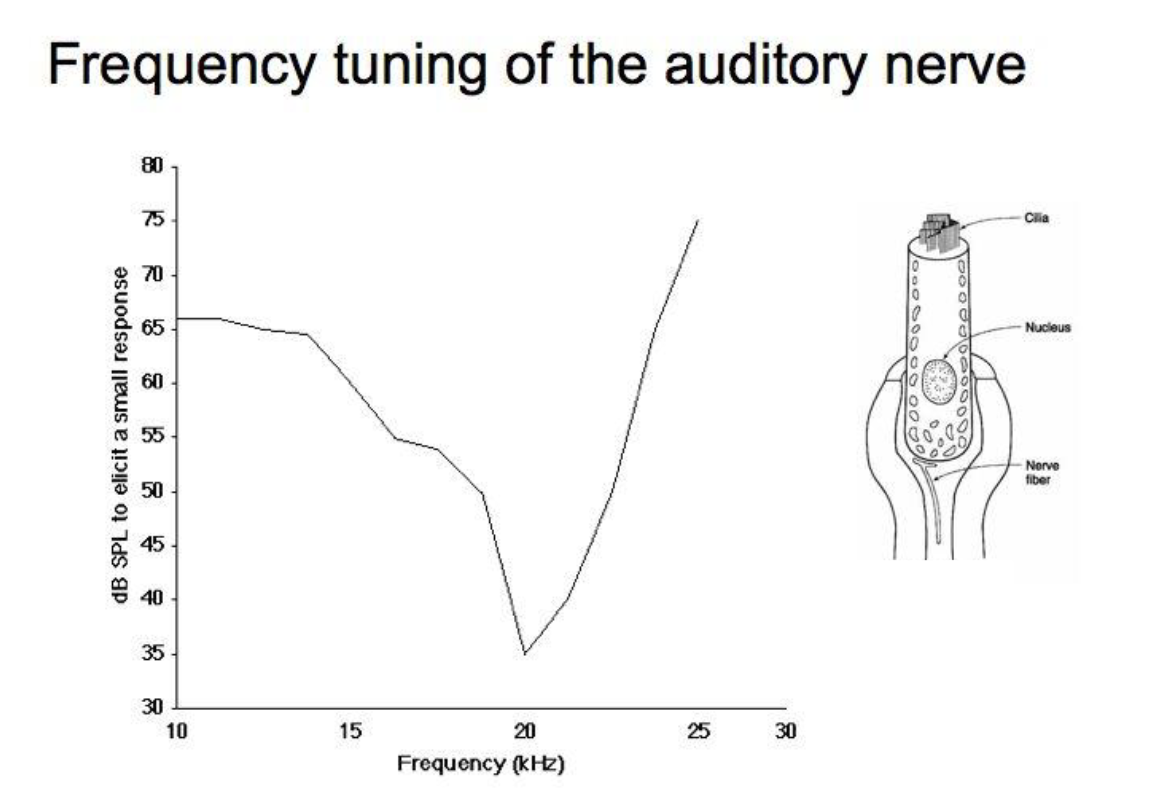
For a given auditory neuron, the same level of activity can be elicited by …?
a faint stimulus at its best frequency
OR
a loud stimulus at a frequency far from that at which its sensitivity is highest
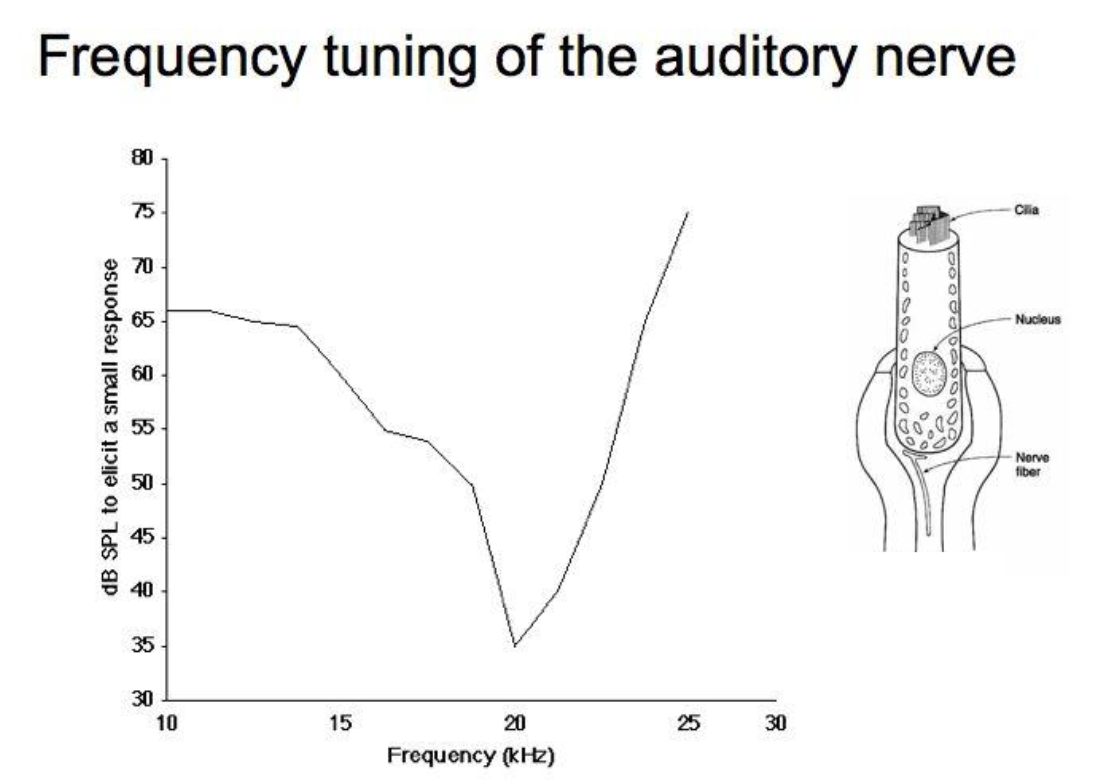
The basilar membrane creates a tonotopic map of sound. What does this mean?
Each point along the basilar membrane has a characteristic frequency
Tonotopy is the spatial arrangement where sounds of similar frequencies are processed
Tonotopy continues throughout the auditory processing centers in the CNS
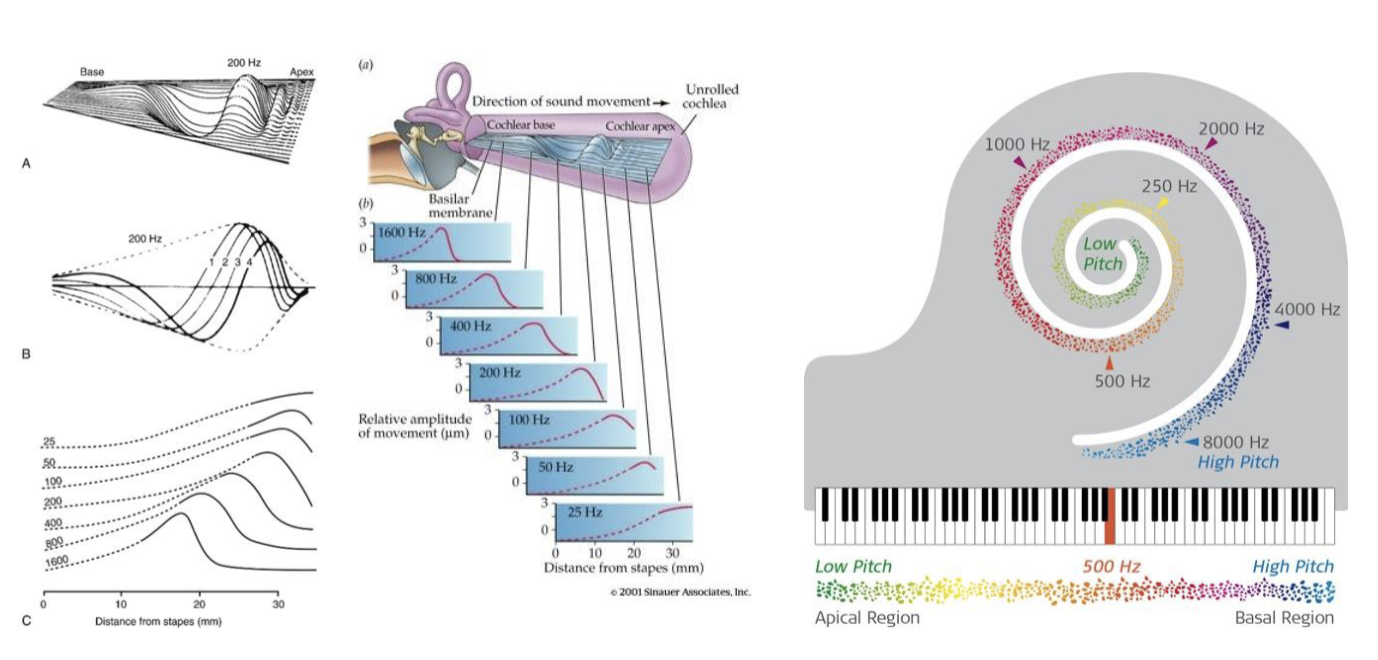
Human speech can range from _____-______ Hz
250-4000 Hz
what are characteristics of the ascending auditory pathway?
pathway has 5 relays, each with a specific job
fast
signals proceed through diverse series of connections
what are the 5 relays within the ascending auditory pathway?
1. Cochlear nuclei (dorsal and ventral)
2. Superior olivary complex
3. Lateral lemniscus
4. Inferior colliculus
5. Medial geniculate nucleus
(before reaching auditory cortex)
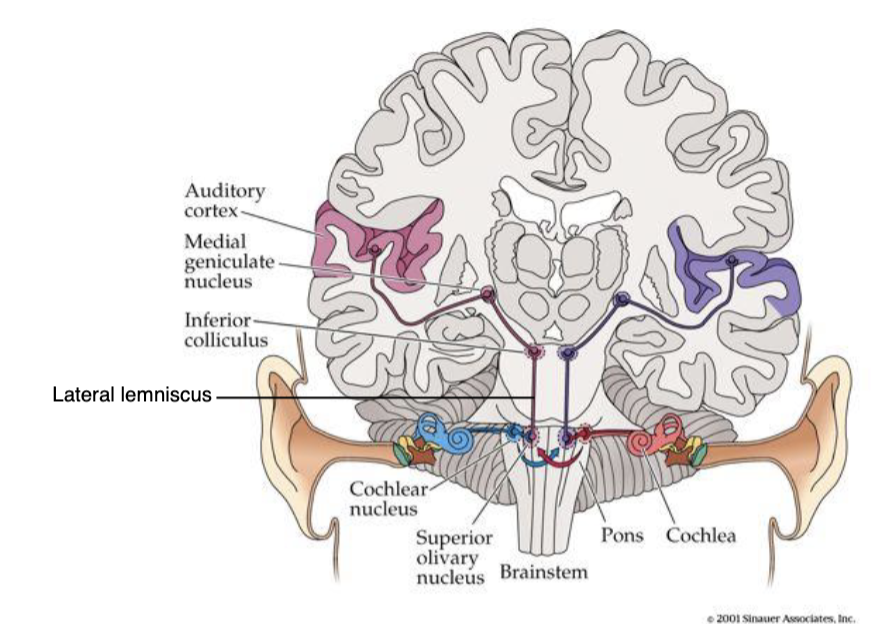
how is the cochlear nucleus divided?
into dorsal and ventral nucleus
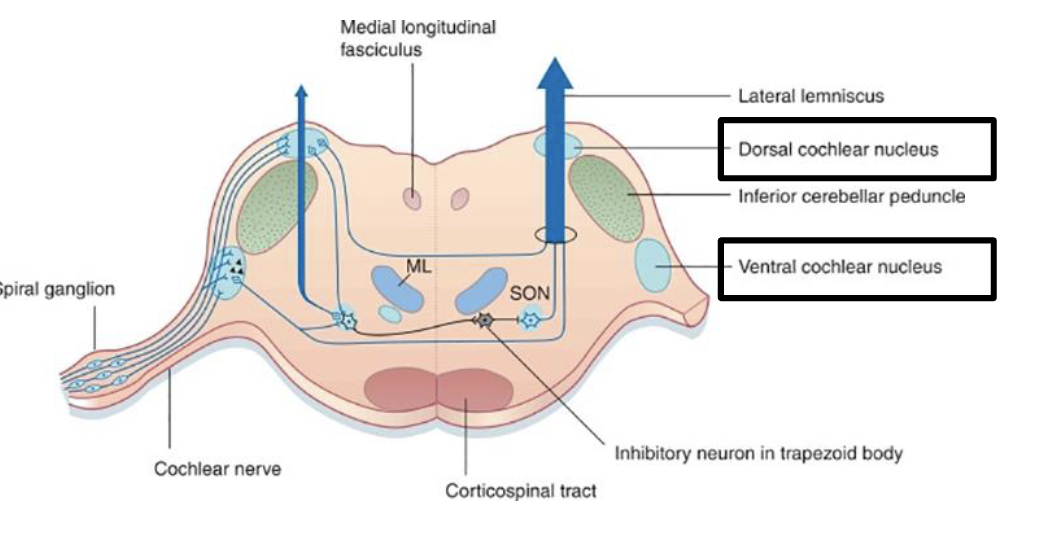
the branches of auditory afferent of CN VIII that enter the brain stem at the pontomedullary junction carry what types of information?
information about tone and intensity of a sound (in the form of action potentials)
Cochlear nuclei will analyze what?
1. Pitch/tone
2. Amplitude – loudness
3. Duration
Auditory afferents of CN VIII enter the brain stem at the __________-, and the majority of axons branch. Where do these branches synapse?
pontomedullary junction
one branch synapses at dorsal cochlear nucleus
other branch synapses at ventral cochlear nucleus
what is the target of the cochlear branch of CN VIII?
Cochlear nucleus
where does the information analyzed by the cochlear nuclei go?
both the ipsilateral and contralateral superior olivary complex
where is the superior olivary complex located?
in the pons
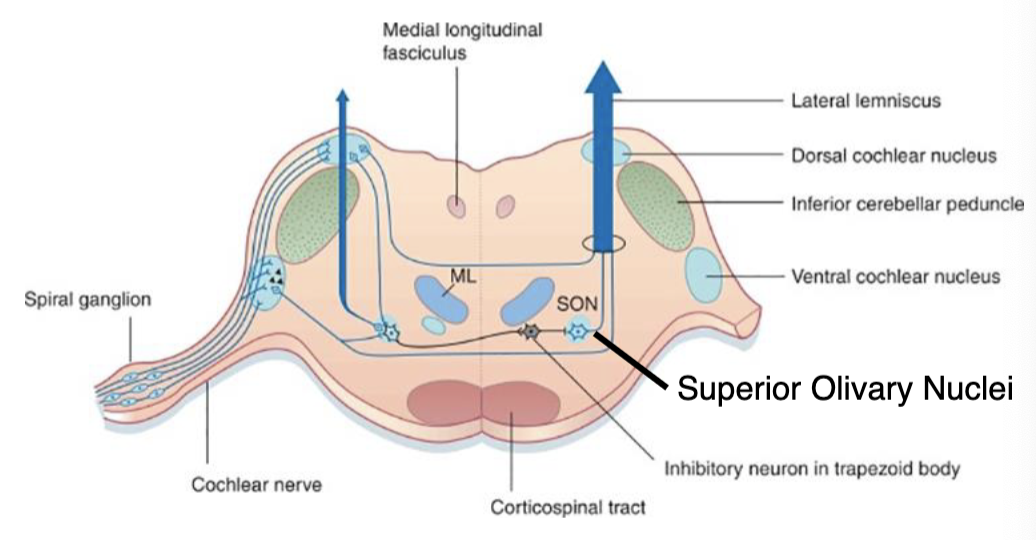
what is the main function of the auditory nuclei in the superior olivary complex? how does it do this?
analyzing where a sound is coming from
The superior olivary complex receives and compares sound from both ears, in order to localize the sources of sounds in the environment
the superior olivary complex is made up of the medial superior olive and the lateral superior olive. what is the function of each?
Interaural intensity difference → lateral superior olive
Interaural timing difference → medial superior olive
what is a theory for how the lateral superior olive computes intensity difference?
LSO neurons compute the difference between inputs coming from the 2 ears
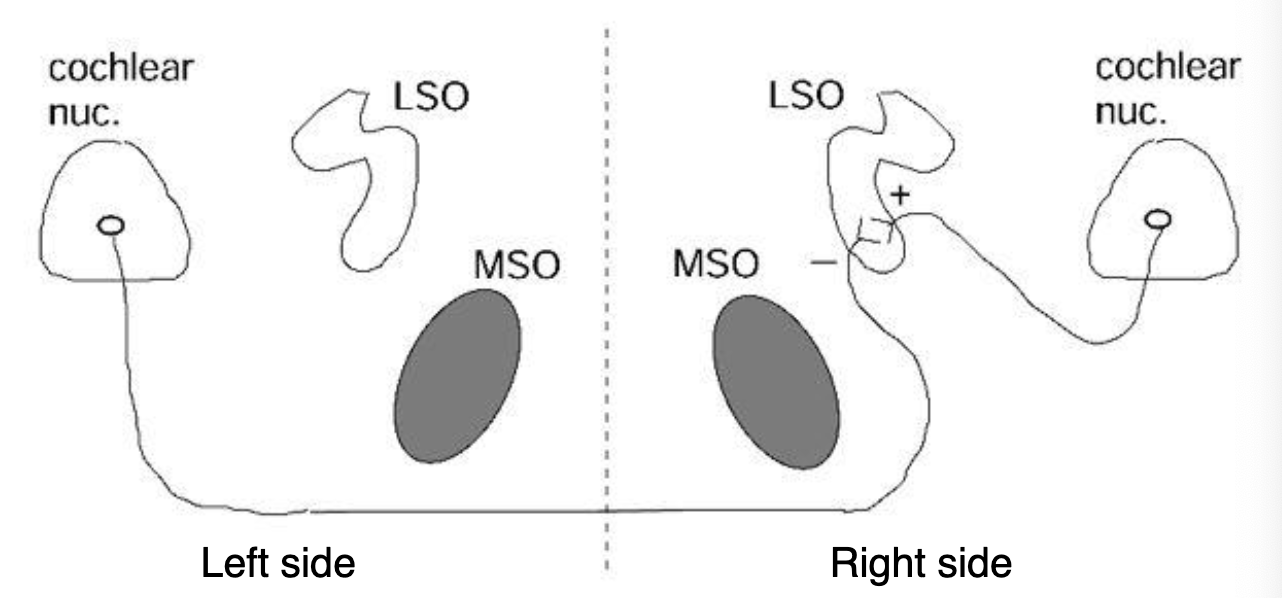
what is a theory for how the medial superior olive computes timing difference?
difference in the timing of sound reaching the ears is 0 for sound directly in front OR 0.7 ms for a sound 90 degrees from center
neuron stimulated if sound reaches both ears simultaneously
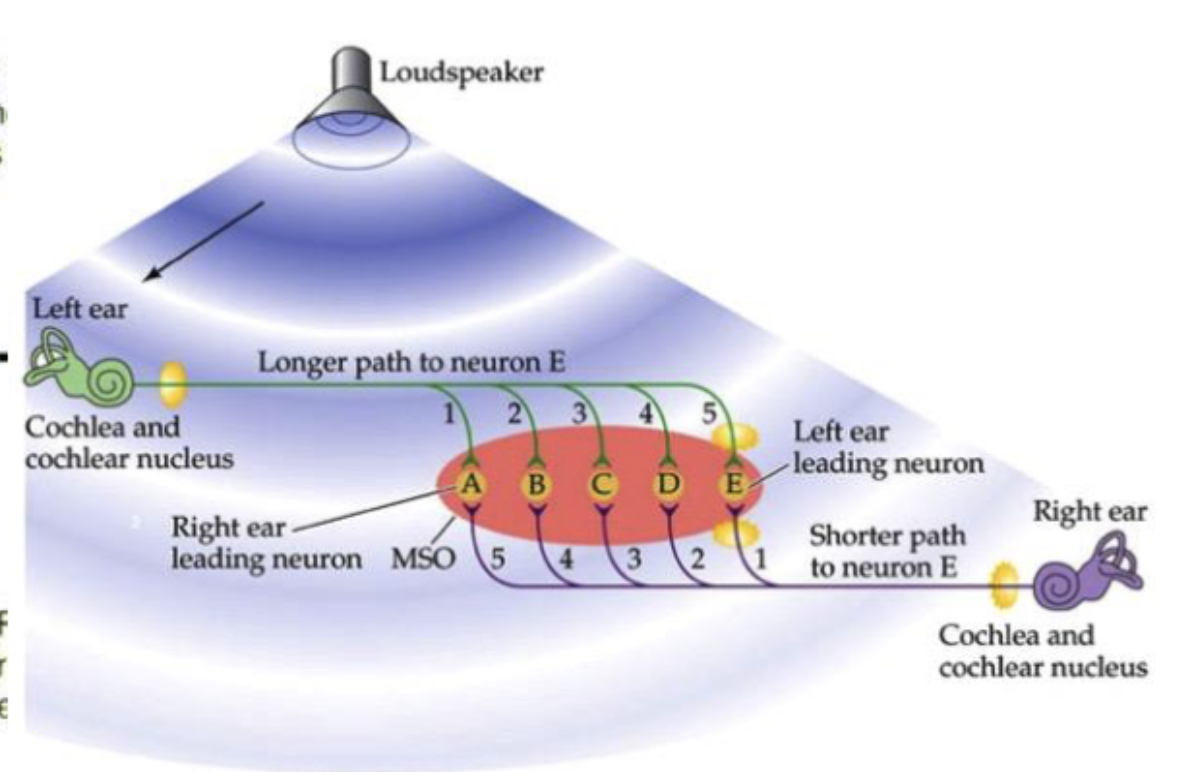
Ascending axons from the superior olive will form a component of the
lateral lemniscus

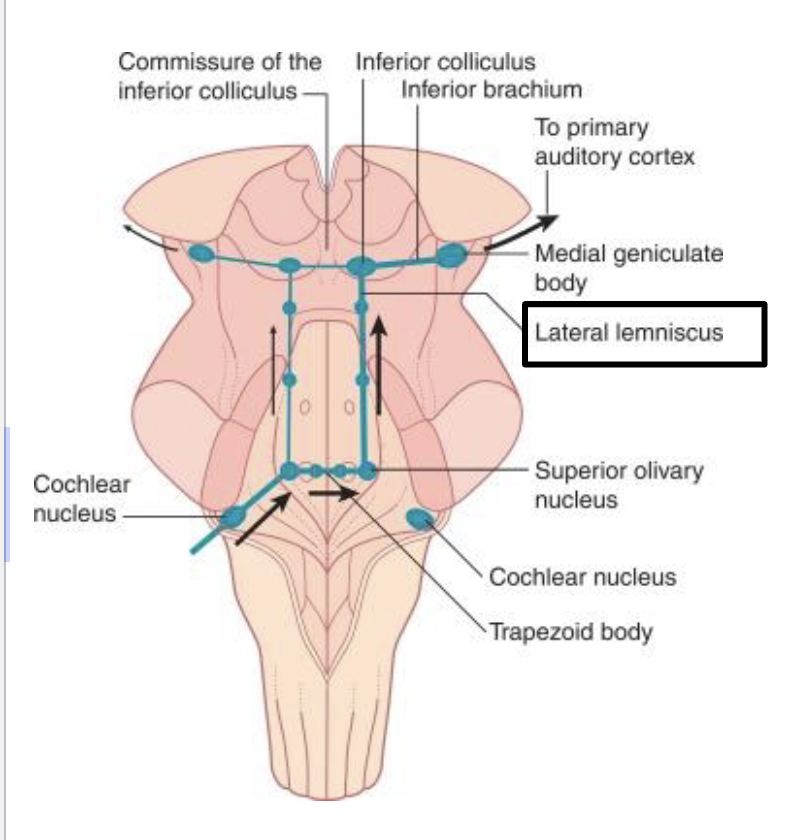
what is the function of the lateral lemniscus?
tract for communication between superior olivary complex and the inferior colliculus
there are some nuclei but its unclear what they do, likely filtering and shaping the dynamic ranges of signals going to the inferior colliculus
what is the principal mid-brain nucleus of the auditory pathway?
inferior colliculus
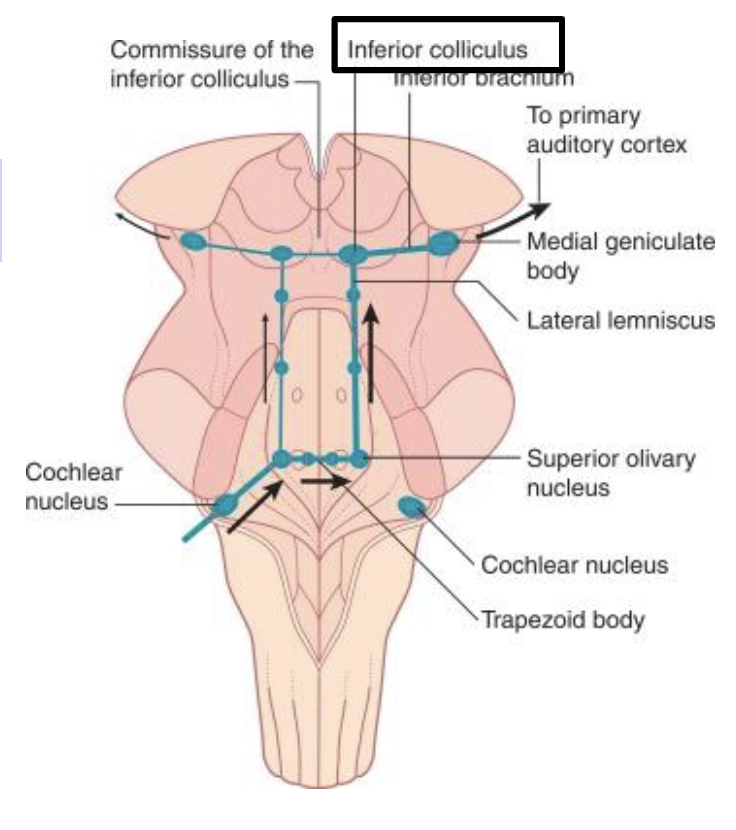
what is the function of the inferior colliculus?
helps localize sounds along the vertical aspect and integrate with horizontal localization
integrates info from the other relay stations primarily integrating spatial and spectral info
may play a role in the startle response and filtering self sounds (vocalization, chewing, respiration)
From the inferior colliculus some fibers cross over to the contralateral IC or ascend to the
Medial geniculate body
where is the medial geniculate body located?
thalamus
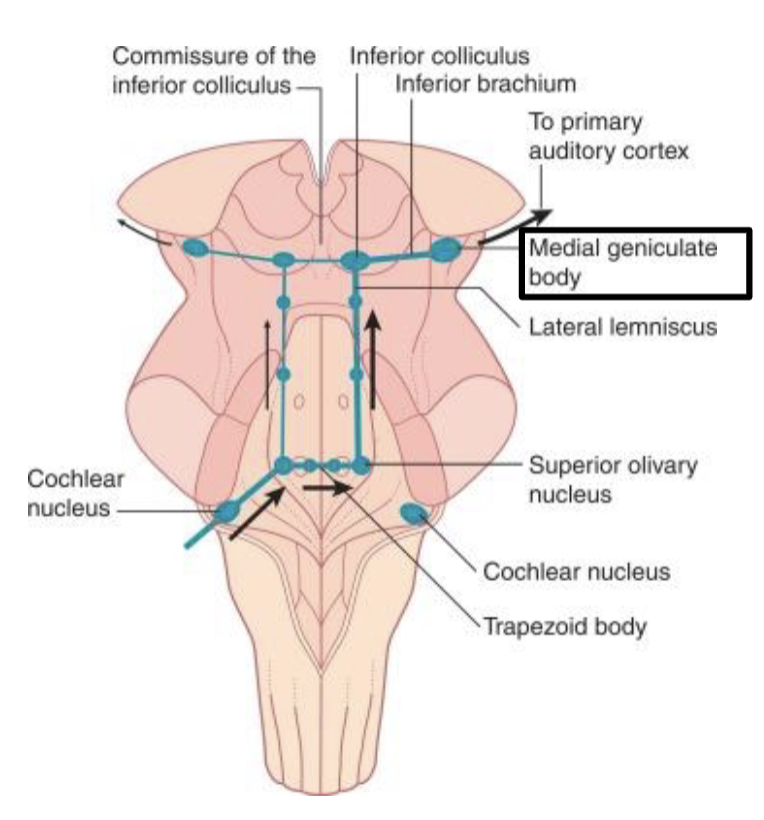
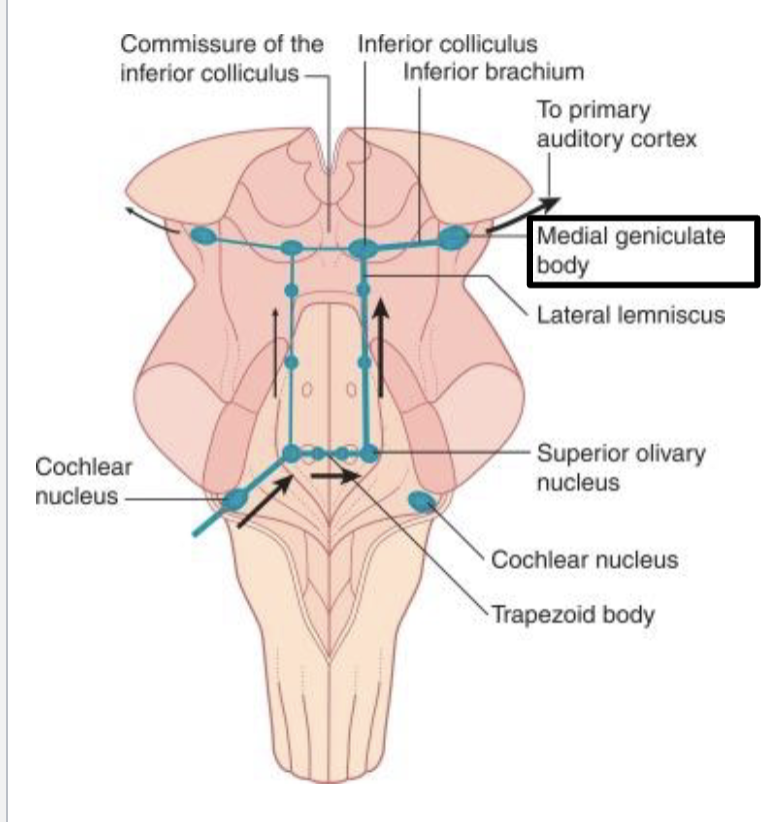
what is the function of the medial geniculate body?
numerous afferent and efferent connections
major role in processing sound frequency, intensity, and timing
influence direction and maintenance of attention
last filter before sound stimuli reach auditory cortex and conscious awareness
Unilateral damage between the lateral lemniscus and auditory cortex results in …?
contralateral sound localization deficits
Unilateral damage below the lateral lemniscus results in …?
localization deficits to either ipsilateral or both sides
where is the auditory cortex located?
in temporal lobe within lateral sulcus
the auditory cortex receives input from the…? and maintains tonotopic arrangement
medial geniculate body
what is the main function of the auditory cortex?
link fundamental aspects of sound that were broken down by previous relay stations in brainstem (harmony, timing, pitch, etc.)
what does it mean that the auditory cortex is biltaeral?
each side of the brain receives input from the left and right ear; but right is more focused on left and vice versa
Left side is more focused on language
Right side is more focused on music
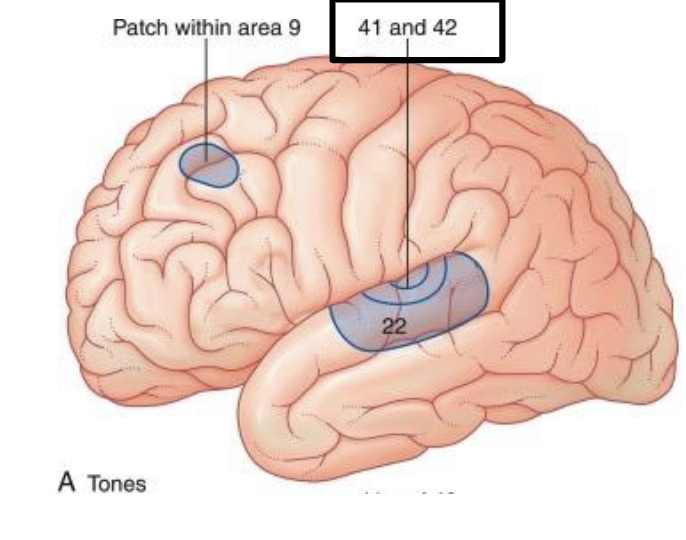
unilateral destruction of primary Broadmann areas of the auditory cortex results in …? what about destruction of both sides?
unilateral destruction = slight hearing loss
bilateral destruction = cortical deafness
what is aphasia?
inability to comprehend and formulate language because of damage to specific brain regions – 1/3 of stroke patients suffer some form of aphasia
Broca’s area (44, 46) are important for…? damage to this area results in…?
language processing
damage = expressive aphasia (halting effortful speech)
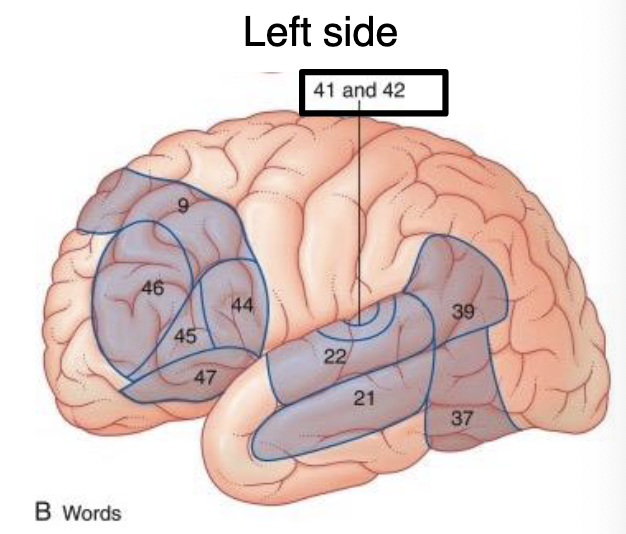
Wernicke’s area (22) are important for…? damage to this area results in…?
comprehension of written and spoken language
damage = receptive aphasia (fluent speech that lacks meaning)

what is the auditory reflex pathway? (what is it triggered by? what is the threshold? what cranial nerves are involved?)
aka acoustic reflex
triggered by high intensity sound + anticipation of vocalization
threshold is usually 10-20 dB below the discomfort threshold
stapedius → CN VII
tensor tympani → CN V3
what are some limitations of the auditory reflex pathway?
muslce fatigue easily (no protection against long sounds)
most useful for low frequencies
no protection against explosive sounds due to comparatively long latency
what is Presbycusis/Noise induced hearing loss?
age-related or long-term exposure to sounds that are either too loud or last too long - damages the hair cells
what is cortical hearing loss?
caused by bilateral lesion of the primary auditory cortex (only 12 reported cases)
efferent input from CN VIII from central auditory pathways to the organ of corti innervate inner/outer hair cells?
efferent → outer hair cells
afferent → inner hair cells
but efferent can inhibit inner hair cells in a select range of tones
what are the types of sensorinueral hearing loss?
presbycusis/noise induced hearing loss
cortical hearing loss
The hair cells responsible for transforming mechanical energy into electrochemical impulses during hearing are located where within the ear?
A. Broca’s area
B. Eustachian tube
C. cochlear nuclei
D. lateral lemniscus
E. organ of corti
E. organ of corti
Which of the following correctly describes inner hair cells?
A. apical hair cells are more easily damaged by prolonged high pitch sounds
B. base has numerous afferent endings
C. located toward the outer edge of the basilar membrane
D. stereocilia are embedded in the tectorial membrane
E. Synapse with axons from CN VII
B. base has numerous afferent endings
From the cochlear nucleus signals in the auditory pathway proceed to what structure in the auditory pathway?
A. Auditory cortex
B. Medial geniculate Body
C. Lateral geniculate Body
D. Semi-circular canal
E. Superior Olivary complex
The function of the auditory reflex pathway is to:
A. Analyze the direction of a sound based on the interaural intensity difference
B. Analyze the direction of a sound based on the interaural timing difference
C. Maintain the tonopic arrangement of auditory neurons
D. Maintain the proper pressure within the middle ear
E. Protect hearing in response to loud sounds
E. Protect hearing in response to loud sounds
CN VIII enters the brainstem at what level?
A. Anterior commissure
B. cerebellum
C. Diencephalon
D. midbrain
E. pontomedullary junction
E. pontomedullary junction